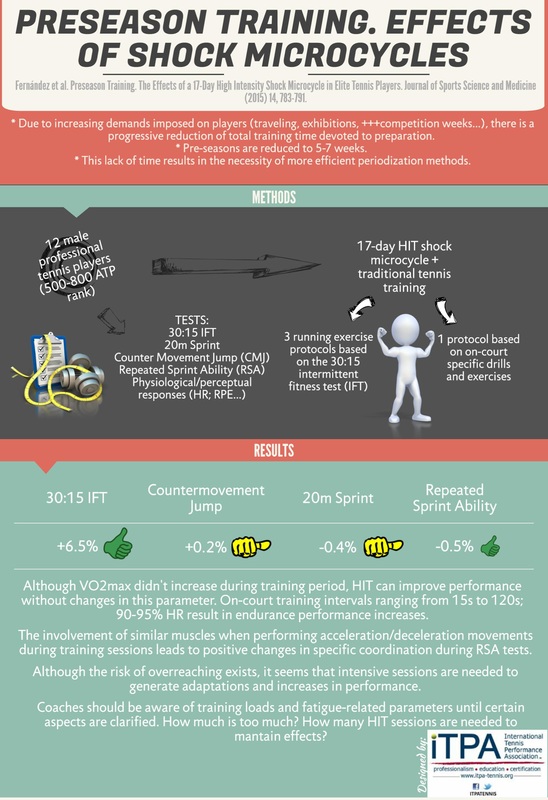12 male professional tennis players (500-800 ATP Ranking) performed a 17-day HIT shock microcycle in addition to conventional tennis training. The program was formed by 3 running protocols based on the Intermittent Fitness Test (IFT) and one protocol based on on-court specific drills (‘Big X’; ‘Suicide’; ‘Recovery/Defensive’…) Data was collected from different tests:
- 30:15 IFT
- 20m Sprint
- Countermovement Jump (CMJ)
- Repeated Sprint Ability (RSA)
- Physiological and perceptual responses (Heart Rate, RPE…)
Results indicated major increases in velocity during IFT (6.5%) and average increases in repeated sprint ability (0.5%). CMJ and 20m sprint remained statistically without significant differences.
Increases in IFT velocity didn’t correspond with increases in VO2max. Studies have demonstrated that endurance can be enhanced without changes in this parameter. These results indicate that training intervals ranging from 15s to 120s at 90-95% of HR result in specific endurance increases.
Regarding RSA improvements, specificity of training that involves similar muscles and acceleration/deceleration patterns result in positive changes in specific coordination during RSA tests.
The major concerning aspects of this type of training is the risk of overreaching/overtraining or potential injury. High intensity bouts at initial stages of season added to normal training can result in highly fatigued athletes. Further studies should be carried out to establish “how much is too much?’’ and “how much is needed to maintain gains?’’ Until then, coaches have to be very aware of load control and fatigue-related parameters like RPE, soreness, recovery quality, sleep parameters, heart rate variability measures, etc.
As coaches, we need to monitor, control and better quantify the load players are exposed to during training. HIT can be considered as a viable addition to a preseason training plan, with appropriate monitoring and understanding of the increased fatigue that is likely to occur to the athlete. Some studies revealed the validity of RPE as an effective method for quantifying load in tennis sessions. It’s the case of Gomes et al. (2015) in which RPE applied to 12 tennis players in 384 on-court tennis sessions; 23 simulated matches and 13 official matches were compared to heart rate values (internal load in this case) for the same players in the same situations. Results gave high correlation between both values and offers an easy technique that doesn’t require sophisticated equipment. This heart rate monitoring allows for relatively low cost monitoring for coaches and tennis performance specialists. Nevertheless, future investigations are needed to demonstrate validity of RPE for recovery aspects, overall season progression and fitness workouts in which specificity, volume, intensity, density and many physical parameters are involved in training.
To learn more about the science and practical application of physical training for tennis, please look into becoming a certified member of the International Tennis Performance Association (iTPA). www.itpa-tennis.org . Learn the latest about tennis specific training and injury prevention at the 2016 WORLD TENNIS FITNESS CONFERENCE (July 30/31st, 2016 in Atlanta, Georgia alongside the BB&T ATLANTA OPEN) www.itpa-tennis.org/tennisfitconference.html
References:
Fernández et al. Preseason Training: The Effects of a 17-Day High-Intensity Shock Microcycle in Elite Tennis Players. Journal of Sports Science and Medicine (2015) 14, 783-791.
Gomes et al. Ecological Validity of Session RPE Method for Quantifying Internal Training Load in Tennis. International Journal of Sports Science & Coaching Volume 10 · Number 4 · 2015.





 RSS Feed
RSS Feed
